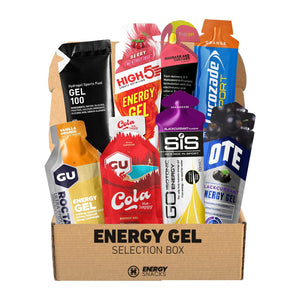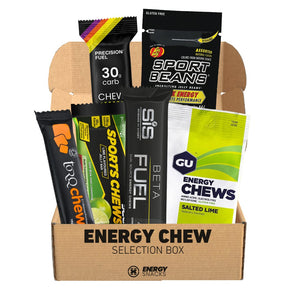It’s your choice - with our knowledge.

Product Insights
Discover more about the products in this article

Energy Gel Selection Box
Featured Products
9 Benefits of Energy Gels and Energy Chews
Energy gels and energy chews are a popular choice among active individuals for boosting energy and endurance.
Both types of products are designed to provide a quick and convenient source of carbohydrates, which are the primary fuel source for the body during intense exercise.
However, there are some key differences between energy gels and energy chews that make them better suited for different types and lengths of activities.
This article will explore the pros and cons of energy gels and energy chews, and help you determine which one is the best option for you to use during your training and competitions.
You can also use our Nutrition Calculator to work out how many gels or chews you need for your session.
Energy Gels
Energy gels are a convenient and portable source of carbohydrates that are often used by active individuals during endurance activities.
They typically come in small packets and are easy to consume on the go, providing a quick boost of energy when needed.
Gels are often made of a complex carbohydrate (like maltodextrin) and also sometimes contain electrolytes and caffeine to help boost performance and prolong the time before fatigue.
They are best consumed during activities and can be taken before, during or after depending on the need and timing.
What are the benefits of energy gels?
- Convenient and easy to consume on the go
- Provide a quick boost of energy
- Can be consumed before or during intense exercise
- Often contain electrolytes to help replace those lost through sweat
- Some gels contain caffeine which can help to boost performance
- They are very lightweight and portable
- They are easy to carry a lot of in one small package
- Many different flavors and varieties available
- Many energy gels are formulated to be easy on the stomach and to help prevent stomach upset
What are the negatives of energy gels?
- Some people may find the texture and taste unappealing.
- Can be expensive depending on the brand and quantity
- Some people experience stomach upset when consuming energy gels
- Some gels contain high levels of caffeine which may not be suitable for everyone or may lead to side effects like jitters or anxiety
- Not all gels contain electrolytes and vitamins that athletes might need.
- Some gels can be sticky and messy to handle
Texture & Taste - Energy Gels
Some people may find the texture and taste unappealing of energy gels. This is due to the fact that there are different types of gels, such as isotonic, thick, jelly, natural, and liquid gels.
-
Isotonic - These are the most common types of energy gels, like SiS Isotonic Gels. They have a texture that is in-between liquid and thick, which some people may find enjoyable, but others may not.
Thick / Jelly - This is a much thicker texture, similar to jelly in some instances, such as GEL 100. They are thicker than isotonic gels, making them harder to swallow and consume. - Natural - Often thicker, with a strong taste, such as Spring Energy gels. They usually have a shorter expiration date, but are a great source of fuel for your training sessions.
- Liquid - These gels have the thinnest consistency and a runnier texture, such as High5's Aqua Gel. These energy gels easy to swallow and consume.
It is important to keep in mind that everyone's preferences are different. Some people may prefer the thicker texture of GEL 100, while others might find it unappealing, and enjoy a liquid gel.
Experimenting with different types of gels, including thick, isotonic, liquid and natural gels, can help you determine which type works best for you and your needs. Try the Energy Snack Energy Gel Selection Box.
Energy Chews
Energy chews are another popular choice for active individuals looking for a convenient source of carbohydrates during endurance activities.
They come in the form of small, chewable tablets or gummies, and typically contain a blend of carbohydrates and electrolytes.
They are similar to gels in terms of the benefits they provide but offer a different texture and consumption method.
They are often consumed during activities and can be taken before or during or after depending on the need and timing. Energy chews are preferred by many as they offer a more appealing taste as well as texture compared to gels.
What are the benefits of energy chews?
- Convenient and easy to consume on the go
- Provide a quick boost of energy
- Often contain electrolytes to help replace those lost through sweat
- Many different flavors and varieties available
- Some people prefer the texture and taste of chews over gels
- They are easy to carry a lot of in one small package
- Many energy chews are formulated to be easy on the stomach
- They are best consumed during activities and can be taken before or during depending on the need and timing
- Some chews come with added vitamins and minerals for more complete nutrition
What are the negatives of energy chews?
- Some people may still find the taste unappealing
- Can be expensive depending on the brand and quantity
- Some people experience stomach upset when consuming energy chews
- Not all chews contain caffeine
- Some chews can be high in sugar and artificial ingredients.
- They may take longer to eat and chew than gels.
Texture & Taste - Energy Chews
When it comes to energy chews, some people may find the texture and taste unappealing.
This is due to the fact that there are different types of textures and flavors available. Some energy chews are gummy, others are soft and others are hard.
-
Gummy - These types of chews have a texture similar to gummy candies, like Clif Bloks. They tend to be more chewy and sticky compared to other types. Some people might find the gummy texture enjoyable while others might not.
-
Soft - These types of chews have a softer texture, like the PF 30 Chews. They tend to be more easy to chew and swallow, but can get mushy quickly if kept in a hot or humid environment.
-
Hard - These types of chews are the hardest type of energy chews, such as TORQ Energy Chew. They are more solid compared to other chews, like a wine gum, and they tend to be longer lasting and some people might find them satisfying to chew.
It's important to keep in mind that everyone's preferences are different and it may take some experimentation to find the energy chew that works best for you.
Some brands offer multiple types of energy chews, such as different textures or flavours, while others just have one type. By trying different types and varieties, you can determine which one is best for you and your needs. Let us help with the Energy Snacks Chews Selection Box.
Conclusion
In conclusion, energy gels and energy chews are both popular choices among active individuals looking for a quick and convenient source of carbohydrates to boost energy and endurance.
Both types of products have their own unique benefits and drawbacks, and choosing the right one for you will depend on your personal preferences and needs.
Energy gels offer a quick and easy way to consume carbohydrates and electrolytes, but may not be suitable for those who dislike the texture or taste.
Energy chews, on the other hand, offer a more appealing taste and texture, but may take longer to consume and may not be suitable for those with dietary restrictions.
To find the best option for you, it's important to keep track of your experiences with different products, take note of what works and what doesn't, and make adjustments as needed.
Experiment with different options, and discard those that don't work for you.
Meanwhile, take note of the products that do provide benefits and make sure to have a consistent supply of them. This way you can optimize your nutrition for the best performance possible.
It’s your choice - with our knowledge.














































































































